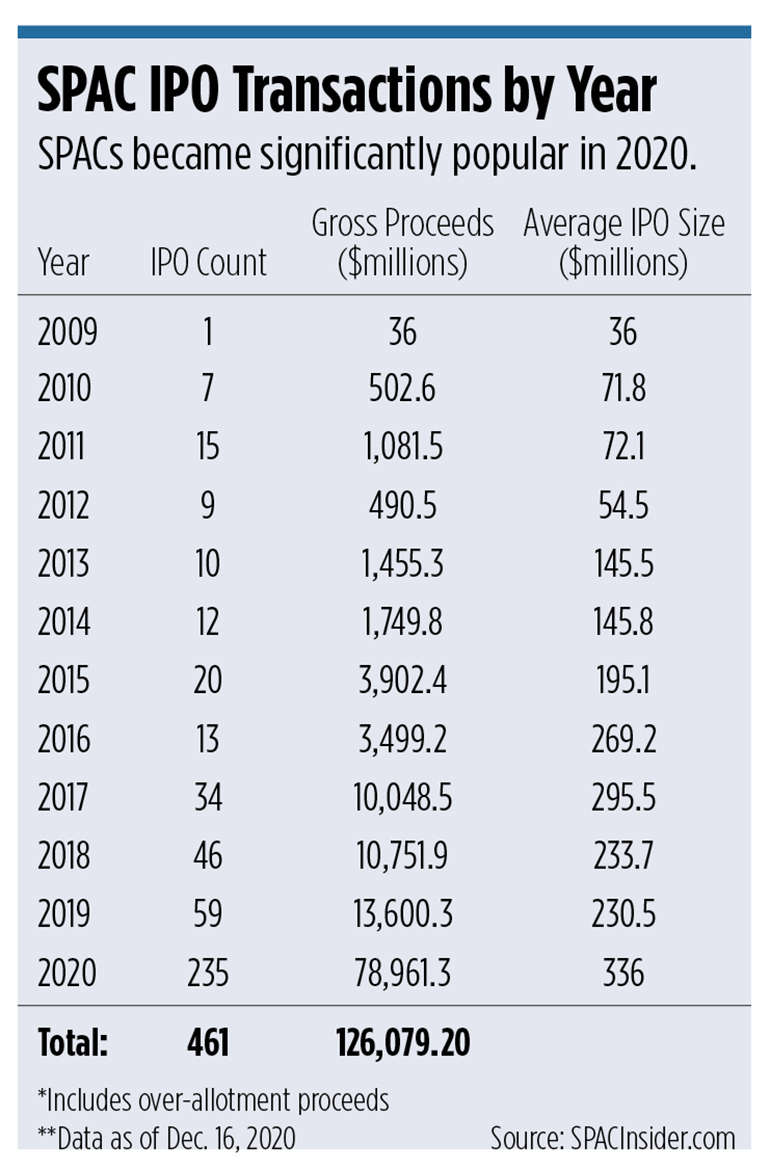Last month, Kingswood Acquisition Corp., a special purpose acquisition corporation, or SPAC, sponsored by the owners of British wealth management firm Kingswood Group and a sister company to advisory firm Kingswood U.S., announced that it had raised $115 million in its initial public offering. Kingswood plans to use the proceeds from the public markets to invest in U.S.-based wealth management firms, bringing a new source of capital and a new option to registered investment advisors considering a sale.
One of the benefits, observers say, is that a SPAC offers long-term capital to a business, whereas most private equity firms—frequently the investors in many large RIA firms currently—seek an exit strategy in four to seven years.
But folks in the RIA M&A space say where the money comes from is less important to sellers, compared with what the finance partner brings to the table in the way of resources, peer group networking and collaboration. With Kingswood’s SPAC being the new kid on the block in terms of deal financing, there aren’t any case studies to consider.
“It does add a new dynamic to the existing acquirer landscape,” said John Eubanks, vice president of Park Sutton Advisors, an investing banking boutique focused on financial services. “But at the end of the day, it’s still very much a sellers’ market, and most of these firms care about the story of the firm, the resources, the operational expertise, and what they bring to the table for their clients and their employees and the funding mechanism is kind of secondary.”
Eubanks said when an entity goes out and acquires a bunch of RIAs, they are often also simultaneously building an operational platform, helping those firms centralize aspects like operations, administration and maybe even investment management.
“To some extent if you’re selling to a brand new group, you really have to look through the SPAC and see who the firm is that’s involved in pulling all these resources together, what they bring to the table today versus what you think they’re going to be able to bring to the table through continued acquisitions,” he said.
“I would agree that the vast majority of people who are contemplating taking a partner into their life’s work—they’re going to look at the people who are driving the culture of the company that’s trying to make the investment in their firm,” said Tim Bello, managing partner at Merchant, a private partnership that takes noncontrolling stakes in RIA firms. “When you’re in a business of human interaction, that’s where everything really lies—the value between the advisor and the client, the relationship between the advisor and the client. And it also applies no differently than that to the internal workings of the company that’s giving the capital to the recipient.”
For investors in the SPAC, however, it's a bet on the wealth management market, even if they don't yet know what firm or firms their money will eventually be invested in. In essence, public investors are betting on a management team to make the right call.
In Kingswood’s case, the partner would be Larry Roth, former CEO of Cetera and director of the SPAC, who has a long history of consolidating firms, as head of some major broker/dealer networks.
“They’ve clearly proven themselves in this industry past, present, will again in the future,” Bello said. “I think the evolution or the broader capital formation of the marketplace, specifically in the independent wealth management arena, is nothing but great for everybody.”
Carolyn Armitage, managing director at ECHELON Partners, agreed that Roth has a good track record, and her firm will consider the SPAC route for their clients. But she said it's too early to know how the SPAC will catch on with advisors.
“It’s yet to be seen what the SPAC is offering to wealth managers for sure,” Armitage said. “We don’t know what the support infrastructure looks like for Kingswood, so how specialized are they? What type of services are they providing and will this expand a current firm’s offering?”
In addition, because Kingswood hasn’t acquired any firms yet, RIAs considering the SPAC don’t know who their peer group would be.
“Reputation is everything in this business,” Armitage said.
Bello agreed that having a community of firms that can collaborate with each other inside an ownership structure is important to RIA operators.
“There are certain businesses when they’re in a community or an ecosystem that kind of feed off of each other, whether it’s just best ideas and study groups, whether it’s co-investing with each other, whether it’s completing each other’s strategies,” he said.
Take Merchant’s ecosystem of 25 RIA firms, for example, some of which don’t do insurance. Some firms in the group have their own general agent, so they will go into a partner firm and fill that gap in their infrastructure, Bello said.
Permanent Capital
Roth said many wealth management firms will like the SPAC structure because they are able to maintain a controlling position in the firm, and the SPAC is not looking to exit in a few years.
But while that is an attractive feature, that’s becoming less and less of an advantage, Armitage said. Given the level of private equity activity in the RIA space, there has not yet been the expected rush of liquidity events.
“The new buzzword in the industry is ‘permanent capital,’ and that’s how many are positioning themselves to get away from that branding of, ‘We’re going to turn you over every four to seven years,’” she said.
Private equity firms are now positioning themselves as longer-term investors, with a nine- to 10-year hold, as opposed to a shorter ownership, “which is more stomachable for the seller, thinking ‘Ten years—I’m not going to be here in 10 years, so that’s fine.’”
The Hot Dot
 Some observers are skeptical of the SPAC structure; it's gained in popularity across industries, and the rising number of IPOs is seen by some as a symptom of overheated equity markets leading more investors into the kinds of speculative bets that SPACs offer, including, with Kingswood's entrance, bets in the wealth management space.
Some observers are skeptical of the SPAC structure; it's gained in popularity across industries, and the rising number of IPOs is seen by some as a symptom of overheated equity markets leading more investors into the kinds of speculative bets that SPACs offer, including, with Kingswood's entrance, bets in the wealth management space.
Through Dec. 16, there have been 235 SPAC IPOs year to date, with gross proceeds exceeding $78 billion, according to SPACInsider.com. In 2019 there were 59 SPAC IPOs and $13.6 billion in gross proceeds.
Just this week, Tuttle Tactical Management launched an actively managed ETF that provides exposure to SPACs, called The SPAC and New Issue ETF (SPCX).
“I’m kind of leery of anything that is the new hot thing because that usually indicates you’re getting in a crowded space,” said Jonathan Henschen, president of the recruiting firm Henschen & Associates. “It sounds like this is a more speculative option for firms that may not have any other options in buying and selling.”





